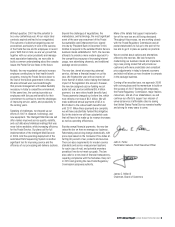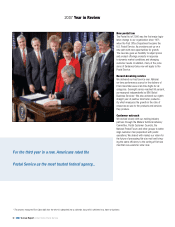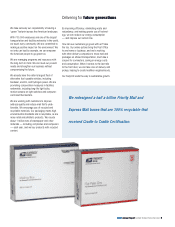US Postal Service 2007 Annual Report Download - page 15
Download and view the complete annual report
Please find page 15 of the 2007 US Postal Service annual report below. You can navigate through the pages in the report by either clicking on the pages listed below, or by using the keyword search tool below to find specific information within the annual report.2007 Annual Report United States Postal Service | 15
Financial Section Part I
Item 1 – Business
Overview
The United States Postal Service (we) commenced operations on July 1,
1971, as an “independent establishment of the executive branch of the
Government of the United States.” We are governed by an eleven-member
Board of Governors. The Board is composed of nine Governors appointed
by the President of the United States with the advice and consent of the
Senate, the Postmaster General and the Deputy Postmaster General. Under
the Postal Reorganization Act, and its successor, the Postal Accountability
and Enhancement Act, Public Law 109-435 ( P.L.109-435), we have a
legal mandate to offer a “fundamental service” to the American people, “at
fair and reasonable rates.” We fulfill this legal mandate to provide universal
service at a fair price by offering a variety of classes of mail services
without undue discrimination among our many customers. This means that
within each class of mail our price does not unreasonably vary by customer
for the levels of service we provide.
We serve individual and commercial customers throughout the nation.
We compete for business in the communications, distribution, delivery,
advertising, and retail markets.
Our mailing services are sold through our almost 37,000 Post Offices,
stations, branches, contract postal units, our website www.usps.com, and a
large network of consignees. We deliver mail to about 148 million city, rural,
Post Office box, and highway delivery points. We conduct our operations
primarily in the domestic market, with international operations representing
less than 3% of our total revenue.
All references to years, unless otherwise stated, refer to our fiscal year
beginning October 1 and ending September 30. All references to quarters,
unless otherwise stated, refer to fiscal quarters within 2007.
We are not a reporting company under the Securities Exchange Act of
1934, as amended, and we are not subject to regulation by the Securities
and Exchange Commission (SEC). However, effective for reporting periods
ending after September 30, 2007, we are required under P.L.109-435 to
file with the Postal Regulatory Commission (PRC) certain financial reports
containing information prescribed by the SEC under section 13 of the
Securities Exchange Act of 1934. These reports are further described on
the following page.
Additional disclosures on our organization and finances, including our
Cost and Revenue Analysis reports; Revenue, Pieces, and Weight reports;
Strategic Transformation Plan 2006–2010; and the Comprehensive
Statement on Postal Operations may be found on our website at www.usps.
com. Information on our website is not incorporated by reference in this
document.
Postal Accountability and Enhancement Act,
Public Law 109-435 (P.L.109-435)
This new postal law was signed by President Bush on December 20, 2006.
It revises a number of provisions of the Postal Service’s governing statute,
codified in Title 39, United States Code.
The new law, once fully implemented, will divide our services into two
broad categories: market-dominant and competitive. Market-dominant
services include, but are not limited to, First-Class Mail, Standard Mail,
and Periodicals. Future rate increases for these services will be subject
to a price cap based on the Consumer Price Index - All Urban Consumers
(CPI-U). Competitive services, such as Priority Mail, Express Mail, Bulk
Parcel Post, and Bulk International Mail will have greater pricing flexibility.
For our retail customers, the new law anticipates that universal service
can be preserved at affordable rates. For commercial mailers, the law is
intended to provide rate predictability. For employees, ratepayers, and
taxpayers, the new law is designed to provide assurance that the employer
portion of the Postal Service’s health and retirement benefits funding
obligations becomes fully funded.
P.L.109-435 also directs the U.S. Treasury to resume financial responsibility
for the portion of the Civil Service Retirement System (CSRS) pensions of
postal employees attributable to military service. This takes the financial
burden added by P.L.108-18, estimated in 2003 at approximately $27
billion by the Office of Personnel Management (OPM), off of the Postal
Service. Our CSRS obligations are now estimated by OPM to be fully
funded as of September 30, 2006, pending future actuarial revaluations.
P.L.109-435 also abolished a federally-mandated escrow requirement
and directed that the money previously held in escrow be placed into a
new Postal Service Retiree Health Benefits Fund (PSRHBF). During the
next ten years we are required to make payments into the PSRHBF that
average $5.6 billion per year. By 2017, we expect our retiree health benefits
obligations will be substantially funded.
P.L.109-435 also reconstitutes the former Postal Rate Commission into
a regulatory body, renamed the Postal Regulatory Commission (PRC).
The PRC released the final regulations pertaining to the new price-setting
process on October 29, 2007. The regulations consist of three parts: (1)
regulations related to rate adjustments for market dominant products,
including the formula for the calculation of the price cap; (2) regulations re-
lated to competitive products; and (3) establishment of a Mail Classification
Schedule, which categorizes our products as either market dominant or
competitive. The PRC will need to issue additional regulations pertaining to
several areas, including the complaint process, reporting requirements, and
commercially sensitive materials.
The Mail Classification Schedule divides mail into market-dominant (herein
after referred to as “mailing services”) or competitive categories (herein
after referred to as “shipping services”), establishes which types of mail
constitute separate products, and presents a brief description of each prod-
uct. The new regulations allow us to make certain classification changes
much more easily than under the previous system, which enhances overall
ratemaking flexibility.
The regulations for mailing services, currently constituting approximately
90% of all postal revenue, allow rate changes every year with limited prior
review, as long as the average increase for each class of mail is no greater
than the rate of inflation as measured by CPI-U. The regulations permit rate
increases above the price cap in the event of extraordinary or exceptional
circumstances.
The regulations for shipping services place no upper limit on rate changes,
and the Governors of the Postal Service can adjust rates as necessary with
the requirements that each competitive product must cover its attributable
costs and no competitive product may be cross-subsidized by mailing
services. In addition, shipping services are required to cover 5.5% of the
Postal Service’s total institutional cost burden.
2007 Annual Report United States Postal Service | 15
























